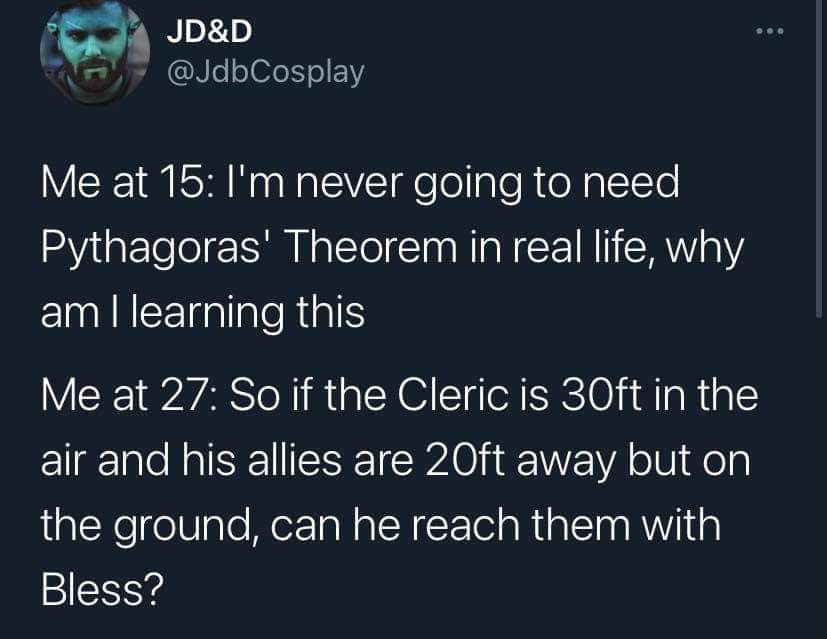this post was submitted on 30 Nov 2023
915 points (99.0% liked)
RPGMemes
11677 readers
898 users here now
Humor, jokes, memes about TTRPGs
founded 2 years ago
MODERATORS
you are viewing a single comment's thread
view the rest of the comments
view the rest of the comments

No he cannot. I don't even need to use the theorem to figure that out. He's already at the maximum range by being 30ft in the air. Unless the party is directly under him, he can't reach.
Ope. Hang on.
Normally this is obviously correct, but in this case, we have to consider how tall the characters are. As a DM, I would rule that if any part of the character (their actual person, not including, say, the reach of the sword they're holding) is within the 30' circle, or could be if they actively collaborated with the cleric using free actions, then the bless would affect them.
There's also a few definitions we need to talk about:
C ◻◻◻ Ain plane T, with 3 empty squares separating them. On a physical table, Carl would also probably be standing on a little platform or a d6 to indicate altitude.Based on some anthropometric data I found very quickly, the average human woman has a vertical reach of about 77 inches or 6' 5". That's naked, and she's probably wearing boots, let's add another inch for the soles so 6' 6".
We can give her a little bit more of an advantage as well; the shortest path between Alice and Carl is a straight line following the radius of the sphere, so she could "lean in" a bit with her arm to get closer. She can't go a full 45 degrees without falling prone though, so this only adds a little. Without a posable figure and a 3d model of the space in front of me I couldn't tell you how much she could reasonably add by pointing her body and hand at an angle, so let's just call it 2 more inches and keep measuring vertically.
We'll call the apex of her fingertips at 80 inches above T a new plane F, and A(F) is the point where she touches that plane with her fingers.
Now we get to actually apply the Pythagorean theorem. It's a triangle formed by the points (C(A) -> A(A) = 240") as leg 1 and (A(A) -> A(F) = 280") as leg 2. The hypotenuse, then, is 368 inches.
30ft is 360 inches. Is 80 inches of Alice enough to put a fingertip through any part of a 30ft sphere around Carl's feet?
No it isn't. So no +d4 for you Alice, piss off.
They did the Monster (Manual) Math!
But did you account for the angle of the terrain.
Man, I love internet nerds
What about the fact that any DnD universe is inherently functioning a set of non euclidean rules with respect to geometry? We know this because moving at a diagonal takes the same amount of movement as a square in one of the cardinal directions.
I would argue that this explanation still requires a working knowledge of the Pythagoras theorem, even if you don't employ the formula directly. Specifically the knowledge that the hypotenuse must be longer than either of the sides unless the angle of the non-90 degree sides are 180 and 0, essentially making it a line.
You deducted the hypotenuse must be longer than 30 since they weren't aiming directly at the ground. Believe it or not, that's not common sense.
I watched (some) of a History of Mathmatics documentary, and what struck me was how many of the theorems ancient people came up with were just common sense. But they wrote it down: that's what made it noteable.
There were some theorems/axioms that i had trouble getting my brain to accept, but generally it came down to me not "getting" their number/tally system or simply having no context for why they needed that math in the first place (ie: it wasn't common sense to me). For example. I'm not an ancient accountant who needs to be able to calculate grain taxes and -- at the same time -- be able to assure a farmer (who can't read my number system) that i'm taking the correct amount of his food, so their method of long division using different colored stones seemed needlessly convoluted to me.
Note, too, that there is value in being rigorous about "common sense" assertions.
Some of the most exciting discoveries happen when something everybody assumed they knew turns out to be wrong.
Very true! I wish I could upvote you more than once, so i'll write a long-winded comment instead...
Quantum mechanics is the least common-sensical realm of science and math, and yet it is excedingly useful and has expanded our understanding of the universe tremendously. But to get here, many someones had to keep asking "why" without stopping at common-sense answers.